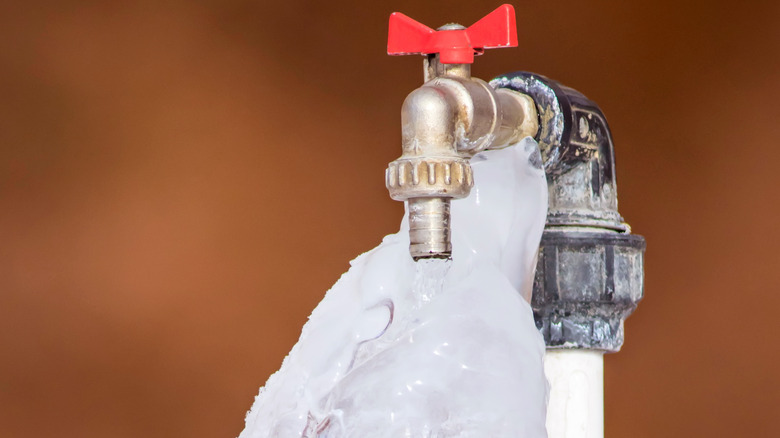Ways to Defend Plumbing System from Freezing: Key Advice
Ways to Defend Plumbing System from Freezing: Key Advice
Blog Article
This article listed below relating to Winter Plumbing Precautions: Preventing Frozen Pipes is unquestionably interesting. Don't overlook it.

Cold weather can wreak havoc on your pipes, particularly by freezing pipes. Below's just how to stop it from occurring and what to do if it does.
Introduction
As temperatures decline, the risk of frozen pipelines rises, possibly causing expensive repairs and water damage. Understanding just how to stop frozen pipelines is important for property owners in cold climates.
Avoidance Tips
Shielding prone pipes
Wrap pipelines in insulation sleeves or make use of heat tape to safeguard them from freezing temperature levels. Concentrate on pipes in unheated or exterior areas of the home.
Home heating techniques
Keep indoor rooms properly warmed, particularly locations with pipes. Open up closet doors to permit warm air to flow around pipelines under sinks.
Exactly how to determine frozen pipelines
Look for decreased water flow from taps, unusual smells or noises from pipelines, and visible frost on revealed pipes.
Long-Term Solutions
Architectural adjustments
Consider rerouting pipes away from exterior walls or unheated locations. Add extra insulation to attics, cellars, and crawl spaces.
Upgrading insulation
Purchase top notch insulation for pipelines, attic rooms, and wall surfaces. Proper insulation aids keep constant temperature levels and reduces the risk of frozen pipelines.
Shielding Exterior Plumbing
Garden tubes and outdoor taps
Disconnect and drain garden tubes before wintertime. Set up frost-proof spigots or cover outside faucets with insulated caps.
Recognizing Icy Pipes
What creates pipes to ice up?
Pipelines ice up when subjected to temperature levels listed below 32 ° F (0 ° C) for extended periods. As water inside the pipelines freezes, it broadens, putting pressure on the pipe walls and potentially triggering them to rupture.
Risks and damages
Frozen pipelines can cause supply of water interruptions, property damages, and expensive repairs. Ruptured pipelines can flooding homes and trigger comprehensive architectural damages.
Indicators of Frozen Piping
Recognizing frozen pipes early can prevent them from breaking.
What to Do If Your Pipes Freeze
Immediate activities to take
If you think icy pipes, maintain taps open up to alleviate pressure as the ice thaws. Utilize a hairdryer or towels taken in hot water to thaw pipes slowly.
Final thought
Preventing frozen pipelines needs aggressive actions and fast responses. By comprehending the causes, indicators, and preventive measures, house owners can protect their plumbing throughout cold weather.
5 Ways to Prevent Frozen Pipes
Drain Outdoor Faucets and Disconnect Hoses
First, close the shut-off valve that controls the flow of water in the pipe to your outdoor faucet. Then, head outside to disconnect and drain your hose and open the outdoor faucet to allow the water to completely drain out of the line. Turn off the faucet when done. Finally, head back to the shut-off valve and drain the remaining water inside the pipe into a bucket or container. Additionally, if you have a home irrigation system, you should consider hiring an expert to clear the system of water each year.
Insulate Pipes
One of the best and most cost-effective methods for preventing frozen water pipes is to wrap your pipes with insulation. This is especially important for areas in your home that aren’t exposed to heat, such as an attic. We suggest using foam sleeves, which can typically be found at your local hardware store.
Keep Heat Running at 65
Your pipes are located inside your walls, and the temperature there is much colder than the rest of the house. To prevent your pipes from freezing, The Insurance Information Institute suggests that you keep your home heated to at least 65 degrees, even when traveling. You may want to invest in smart devices that can keep an eye on the temperature in your home while you’re away.
Leave Water Dripping
Moving water — even a small trickle — can prevent ice from forming inside your pipes. When freezing temps are imminent, start a drip of water from all faucets that serve exposed pipes. Leaving a few faucets running will also help relieve pressure inside the pipes and help prevent a rupture if the water inside freezes.
Open Cupboard Doors
Warm your kitchen and bathroom pipes by opening cupboards and vanities. You should also leave your interior doors ajar to help warm air circulate evenly throughout your home.

I have been very involved in How to prepare your home plumbing for winter weather and I'm hoping you appreciated the entire page. Enjoyed our article? Please quickly share it. Let other people discover it. We appreciate your readership.
Website Report this page